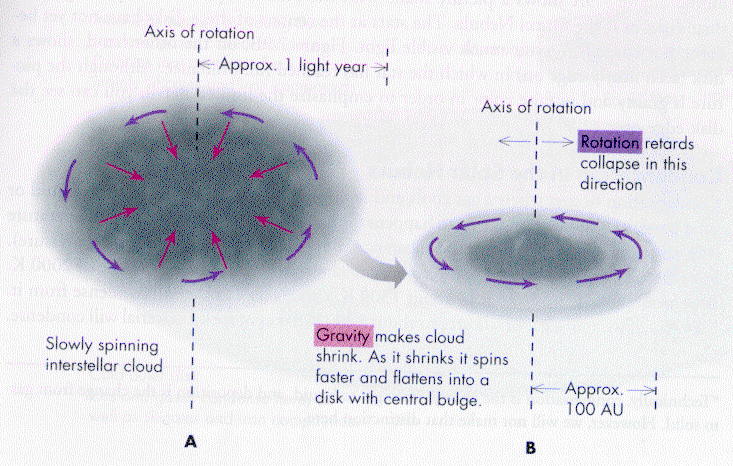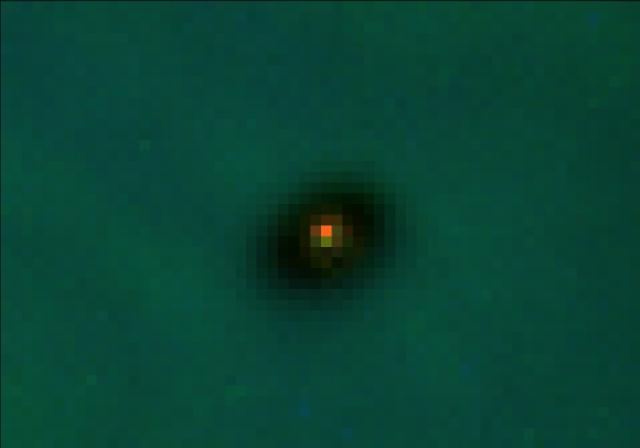Star Formation
| Intergalactic space is filled with
clouds of gas
(mostly H + He) and dust known as molecular clouds.
These clouds are supported against
gravitational collapse
by their thermal pressure, but if the clouds get too big massive,
gravity wins and they can start to collapse. This is the first step
towards star formation.
Once started, how does the collapse form
a star
and the disk of material surrounding it?
Gravity is a central
force
-- it draws material in radially. So why
doesn't
it all collapse into a ball?
|
 |
Angular Momentum
All clouds rotate, at least a
little,
due to gravitational shearing in the galaxy's disk. And if a cloud
rotates,
it has angular momentum: L ~ mrv.
And remember that angular
momentum
is conserved. So if a rotating cloud collapses (r gets
smaller)
than it must spin faster (v gets bigger). Even a little pre-collapse
spin
goes a long way!
How does rotation affect collapse? It adds a
centripetal
force term to the collapse. For a particle of mass m on the edge of the
cloud, the force on it depends whether it is on the rotation pole or
the
equator:

So as the cloud collapses, material along the spin
axis
can collapse onto the star, but material in the spin plane has collapse
halted by centripetal force. A disk is formed!

What about the central mass -- the protostar
itself?
As a ball of gas collapses, its gravitational
potential
energy changes. Half of this change is radiated away, the other half
heats
up the collapsing cloud.
So the very central portions of the cloud are
getting
denser and hotter. Eventually the density and temperature will become
high
enough that nuclear reactions will begin to take place. A
star is born!
The high central density and temperature also create
sufficient
pressure (via the ideal gas law) inside the star to halt gravitational
collapse. The young star is now in hydrostatic equilibrium.
Nice theory. Does it have
anything to do with reality?
Yes!
We see these stars and young disks in nearby star
forming regions:
The Orion Nebula

Proplyds (Proto
Planetary
Disks) in the Orion star
forming cloud
The Solar Nebula
Okay, so we made a star and had some leftover stuff in
a
disk around it. This leftover stuff is called the solar
nebula, and it is the stuff from which the planets formed.
What
more can we say about it?
What is it made of?
It came from the same
collapsing
cloud which formed the Sun, so it should have the same chemical
composition
as the Sun. Mostly hydrogen and helium, with much smaller amounts of
heavier
elements: carbon, nitrogen, silicon, sulfur, iron, etc.
Also, the chemical
composition of
meteorites is similar to the Sun, minus the volatile elements such as
hydrogen,
helium, and other gases.
How hot was it?
Recall that the proto-Sun is
undergoing
gravitational collapse as it forms, and that gravitational collapse
produces
a lot of heat. As the collapse slows, less energy is released - remember
our calculation of Jupiter's heat in the last homework set.
So the early solar nebula
was
very hot, and cooled rapidly.
The inner solar system was
probably
at temperatures > 2000 K. Once collapse was halted and the disk
formed,
the nebula cooled to ~ 800 K. After the disk was finally cleared of
material
and the planets formed, the solar system temperatures eventually
dropped
to the current equilibrium values.
Where did it all go?
Eventually, the stellar wind and radiation
pressure
from the central star blew much of the material out of the inner solar
system (remember the physics of comet tails?). But before that
happens,
we need to start making planets...





